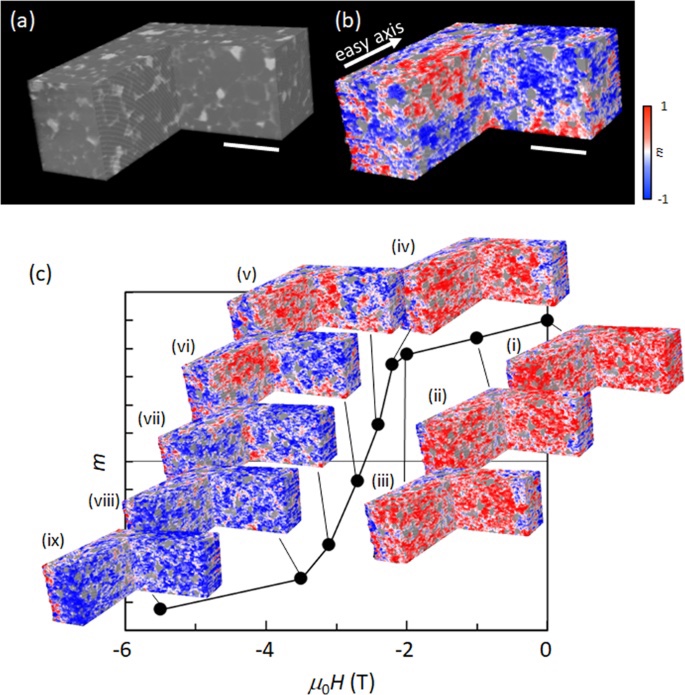
SPring-8: 3D shooting of neodymium magnets!
– Significance of the success of Tohoku University and others –
Tohoku University,
Kwansei Gakuin University
Synchrotron Radiation Research Center
National Institute for Materials Science
Daido Steel
They succeeded in “taking three-dimensional images of the magnetic domains of a magnet.”
It captures “the state in which the magnetic pole is reversed inside the magnet as the magnet loses to the surrounding magnetic field.”
Multiple reverse propagation modes were confirmed.
This leads to elucidation of the principle of magnet performance.
3D imaging of magnetic domains:
Magnetic information inside the magnet was measured using hard X-rays from a large synchrotron radiation facility (SPring-8).
It was rotated like a computed tomography (CT) and measured.
“We reconstructed the 3D model.”
Shooting neodymium magnets:
A neodymium magnet was processed into a columnar shape with a side of 18 μm, and photographed while applying a magnetic field.
“The appearance of the magnetic domains inside the magnet reversing one by one” was captured.
We found “a crystal grain that reverses by itself and spreads out” and a crystal grain that can endure to the end.
The grain principle turned out:
Understanding the principle behind these grains will lead to higher performance.
It was confirmed that “a plurality of reverse propagation modes exist”.
Depending on the type of magnet or soft magnetic material, the mode that appears may change.
It can be used for material structure design.
new switch
Three-dimensional Perspective of the Behavior of Micro Magnets Inside State-of-the-Art Permanent Magnet Materials One Step Forward in Elucidating the Coercive Force Mechanism for Development of Ultra-High-Performance Magnets (Press Release) — SPring-8 Web Site
http://www.spring8.or.jp/ja/news_publications/press_release/2022/220823/
SPring-8 : tournage 3D d’aimants néodyme !
– Importance du succès de l’Université du Tohoku et d’autres –
Université du Tohoku,
Université Kwansei Gakuin
Centre de recherche sur le rayonnement synchrotron
Institut national des sciences des matériaux
Daido Acier
Il a réussi à “prendre des images tridimensionnelles des domaines magnétiques d’un aimant”.
Il capture “l’état dans lequel le pôle magnétique est inversé à l’intérieur de l’aimant lorsque l’aimant perd face au champ magnétique environnant”.
Plusieurs modes de propagation inverse ont été confirmés.
Cela conduit à l’élucidation du principe de la performance de l’aimant.
Imagerie 3D de domaines magnétiques :
Les informations magnétiques à l’intérieur de l’aimant ont été mesurées à l’aide de rayons X durs provenant d’une grande installation de rayonnement synchrotron (SPring-8).
Il a été tourné comme une tomodensitométrie (CT) et mesuré.
“Nous avons reconstruit le modèle 3D.”
Tirer des aimants en néodyme :
Un aimant en néodyme a été transformé en une forme de colonne avec un côté de 18 μm et photographié tout en appliquant un champ magnétique.
“L’apparition des domaines magnétiques à l’intérieur de l’aimant s’inversant un par un” a été capturée.
Nous avons trouvé “un grain de cristal qui s’inverse de lui-même et s’étale” et un grain de cristal qui peut durer jusqu’au bout.
Le principe du grain s’est avéré:
Comprendre le principe derrière ces grains conduira à de meilleures performances.
Il a été confirmé qu'”il existe une pluralité de modes de propagation inverse”.
Selon le type d’aimant ou de matériau magnétique doux, le mode qui apparaît peut changer.
Il peut être utilisé pour la conception de structures matérielles.
nouvel interrupteur
Perspective tridimensionnelle du comportement des micro-aimants à l’intérieur des matériaux d’aimants permanents de pointe Un pas en avant dans l’élucidation du mécanisme de force coercitive pour le développement d’aimants à ultra-haute performance (Communiqué de presse)
SPring-8: 3D-Schießen von Neodym-Magneten!
– Bedeutung des Erfolgs der Universität Tohoku und anderer –
Tohoku-Universität,
Kwansei-Gakuin-Universität
Forschungszentrum für Synchrotronstrahlung
Nationales Institut für Materialwissenschaft
Daido Stahl
Ihm gelang es, „dreidimensionale Bilder der magnetischen Domänen eines Magneten zu machen“.
Es erfasst „den Zustand, in dem der Magnetpol innerhalb des Magneten umgekehrt wird, wenn der Magnet an das umgebende Magnetfeld verliert“.
Mehrere Rückwärtsausbreitungsmodi wurden bestätigt.
Dies führt zur Erläuterung des Prinzips der Magnetleistung.
3D-Bildgebung magnetischer Domänen:
Magnetische Informationen im Inneren des Magneten wurden mit harter Röntgenstrahlung aus einer großen Synchrotronstrahlungsanlage (SPring-8) gemessen.
Es wurde wie ein Computertomograph (CT) gedreht und vermessen.
„Wir haben das 3D-Modell rekonstruiert.“
Schießen von Neodym-Magneten:
Ein Neodym-Magnet wurde zu einer Säulenform mit einer Seitenlänge von 18 &mgr;m verarbeitet und fotografiert, während ein Magnetfeld angelegt wurde.
„Das Erscheinen der magnetischen Domänen innerhalb des Magneten, die sich nacheinander umkehren“ wurde erfasst.
Wir fanden “ein Kristallkorn, das sich von selbst umkehrt und ausbreitet” und ein Kristallkorn, das bis zum Ende bestehen kann.
Das Getreideprinzip stellte sich heraus:
Das Verständnis des Prinzips hinter diesen Körnern führt zu einer höheren Leistung.
Es wurde bestätigt, dass “mehrere Rückwärtsausbreitungsmodi existieren”.
Je nach Art des Magneten oder weichmagnetischen Materials kann sich der angezeigte Modus ändern.
Es kann für das Materialstrukturdesign verwendet werden.
neuer Schalter
Dreidimensionale Perspektive des Verhaltens von Mikromagneten in hochmodernen Permanentmagnetmaterialien – ein Schritt vorwärts bei der Aufklärung des Koerzitivkraftmechanismus für die Entwicklung von Ultrahochleistungsmagneten (Pressemitteilung) – SPring-8-Website
Real picture of magnetic domain dynamics along the magnetic hysteresis curve inside an advanced permanent magnet
NPG Asia Materials
Abstract
In the long history of permanent magnet research for more than 100 years,
three-dimensional magnetic microscopy has been eagerly awaited to elucidate the origin of the magnetic hysteresis of permanent magnets.
In this study,
we succeeded in observing the three-dimensional magnetic domain structure of an advanced high-coercivity Nd-Fe-B-based permanent magnet throughout the magnetic hysteresis curve
using a recently developed hard X-ray magnetic tomography technique.
Focused-ion-beam-based three-dimensional scanning electron microscopy
was employed to study the relationship between the observed magnetic domains and the microstructure of the magnet for the same observing volume.
Thermally demagnetized and coercivity states exhibit considerably different magnetic domain structures but show the same periodicity of 2.3 μm,
indicating that the characteristic length of the magnetic domain is independent of the magnetization states.
Further careful examination revealed some unexpected magnetic domain behaviors,
such as running perpendicular to the magnetic easy axis and reversing back against the magnetic field.
These findings demonstrate a wide variety of real magnetic domain behaviors along the magnetic hysteresis inside a permanent magnet.